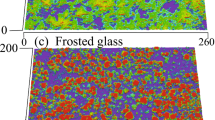Abstract
Changes in the intrinsic structure of paint surfaces resulting from extended UV exposure can significantly alter the appearance of paint due to a breakdown in the resin that binds the pigments and flattening agents. In this study, the coating structure of a solvent-based poly-urethane was analyzed to establish correlations between the intrinsic spatial scaling properties of the coating and UV exposure time. Atomic force microscopy and laser scanning confocal microscopy were employed to map surface structures over a range of scales from 80 nm to 80 εm. The roughness of the polyurethane surface was characterized in terms of scaling exponents using detrended fluctuation analysis to identify long-range, power law relations, and to correct for inhomogeneities in the surface structure. The time-dependence of the roughening process was also determined and correlated with changes in gloss.
Similar content being viewed by others
References
Sung, L., Nadal, M.E., McKnight, M., Marx, E., and Laurenti, B., “Optical Reflectance of Metallic Coatings: Effect of Aluminum Flake Orientation,”Journal of Coatings Technology,74, No. 932, 43 (2002).
Hegedus, C.R. and Kloiber, K.A., “Aqueous Acrylic-Polyurethane Hybrid Dispersions and Their Use in Industrial Coatings,”Journal of Coatings Technology,68, No. 860, 39 (1996).
Pomposo, T., Awamura, D., and Ode, T, “Vertical Profiling, CD Measurements, and 3D Surface Profiling with a Confocal Laser Scanning Microscope,”SPIE Proc. Surface Characterization and Testing, 1164 (1989).
Raghavan, D., VanLandingham, M., Gu, X., and Nguyen, T., “Characterization of Heterogeneous Regions in Polymer Systems Using Tapping Mode and Force Mode Atomic Force Microscopy,”Langmuir, 16, 9448–9459 (2000).
Magonov, S.N., Ellings, V., and Whangbo, M.H.,Surf. Sci., 375, L385 (1997).
Turcotte, D.,Fractals and Chaos in Geology and Geophysics, Cambridge University Press, Cambridge, 1992.
Korvin, G.,Fractal Models in the Earth Sciences, Elsevier Science Publishers, Amsterdam, 1992.
Gouyet, T.F., Rosso, M., and Sapoval, B.,Fractals and Disordered Systems, Springer, Berlin, 1991.
Barabasi, A.L. and Stanley, H.E.,Fractal Concepts in Surface Growth, Cambridge University Press, New York, 1995.
Meisel, L.V., Scanlon, R.D., Johnson, M.A., and Lanzerotti, Y.D., “Self-Affine Analysis on Curved Reference Surfaces: Self-Affine Fractal Characterization of TNT Fracture Surface,”Shock Compression of Condensed Matter, 1, 727–730 (1999).
Cote, P.J. and Johnson, M.A., “Self-Affine Scaling Analysis of Coating Structure,”Proc. of the SPIE Visual and Information Processing Conference, 3716, 2–8 (1999).
Peng, C.K., Buldyrev, S.V., Goldberger, A.L., Havlin, S., Sciortino, F., Simons, M., and Stanley, H.E., “Long-Range Correlations in Nucleotide Sequences,”Nature, 356, 168–171 (1992).
Peng, C.K., Buldyrev, S.V., Havlin, S., Simons, M., Stanley, H.E., and Goldberger, A.L., “Mosaic Organization of DNA Nucleotides,”Phys. Rev. E, 49, 2, 1685–1688 (1994).
U.S. Department of Defense. “Coating Polyurethane, High Solids. MIL-PRF-85285,” Washington, D.C. (April 30, 1997).
Crawford, A., Escarsega, J., Kosik, W., Lum, W., Patterson, P., Smith, P., Bishop, A., Cote, P., Johnson, M., and Kendall, G.,Proc. 29th International Waterborne, High-Solids and Powder Coatings Symposium, New Orleans, LA, February 2002.
U.S. Department of Defense. “Primer Coatings; Epoxy, High-Solids. MIL-PRF-23377H.” Washington, D.C. (September 30, 1999).
U.S. Department of Defense. “Chemical Conversion Coatings on Aluminum and Aluminum Alloys. MIL-C-5541,” Washington, D.C. (November 30, 1990).
Digital Instruments Corporation, 112 Robin Hill Road, Santa Barbara CA, USA.
Lasertec USA Inc., 2001 Gateway Place, Suite 130, San Jose, CA 95110.
Pomposo, T., Awamura, D., and Ode, T., “Vertical Profiling, CD Measurements, and 3D Surface Profiling with a Confocal Laser Scanning Microscope,”SPIE Proc., Surface Characterization and Testing, 1164 (1989).
Gonzalez, R.C. and Wintz, P.,Digital Image Processing. Addison-Wesley Publishing, Massachusetts, 1987.
Johnson, M.A. and Cote, P.J., “Characterization of Metastable Structures in Sputtered Coatings,”Proc. of the Systemics, Cybernetics, and Informatics Conference, 6, 298–303, (2001).
Lum, W.S., Patterson, P.H., and Escarsega, J.A., “Mechanisms of Military Coatings Degradation: Color and Gloss Performance Evaluation,” Army Research Laboratory Technical Report #ARL-TR-2670 (2002).
Author information
Authors and Affiliations
Additional information
AMSTA-AR-CCB-TA, Watervliet, NY 12189-4050. Email: majohn@pica.army.mil and pcote@pica.army.mil
Rights and permissions
About this article
Cite this article
Johnson, M.A., Cote, P.J. Detrended fluctuation analysis of UV degradation in a polyurethane coating. Journal of Coatings Technology 75, 51–57 (2003). https://doi.org/10.1007/BF02720522
Issue Date:
DOI: https://doi.org/10.1007/BF02720522




